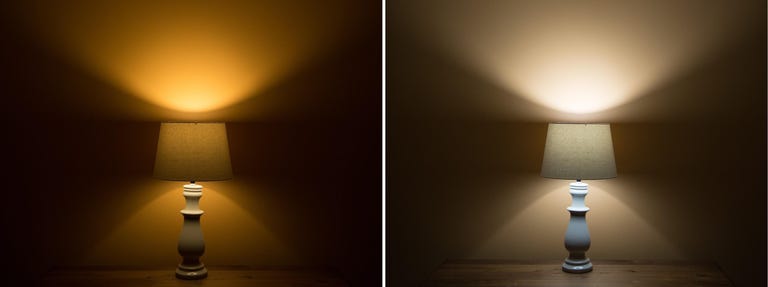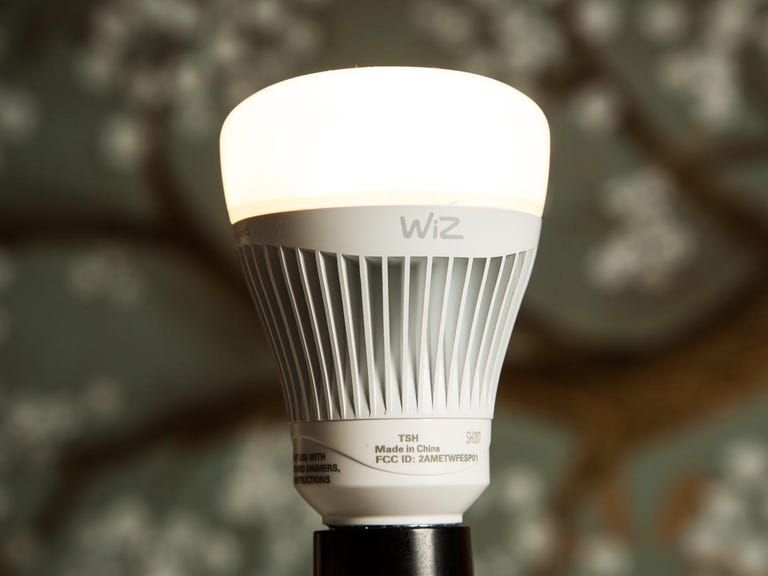 Why You Can Trust CNET
Why You Can Trust CNET Wiz Color Wi-Fi Smart LED Starter Kit review: These smart, multicolor Wi-Fi bulbs are a little too clunky
These color-changing LEDs work with Alexa and Google Home, need no hub and cost less than Lifx or Hue. The problem? They aren't very bright.
Editor's Note, 5:15 PM EST, 9/15/17: This review originally claimed in error that the Wiz LEDs did not have a white-light setting brighter than 450 lumens. In actuality, there's a 4,200 K setting that reaches 807 lumens, roughly on par with a 60W replacement incandescent. The review text has been updated accordingly, and the score has changed from a 6.2 to a 6.9.
The Good
The Bad
The Bottom Line
Take a walk through your local lighting aisle and you'll find plenty of good LED options for $5 or less. Color-changing smart bulbs, on the other hand, are still pretty expensive -- big-name options like Lifx and Philips Hue typically charge about $50 per bulb.
In that sense, the Wiz LEDs are a slight step in the right direction. For $70, you get two color-changing smart bulbs, plus a handy physical remote for quick adjustments. Like their more expensive competitors, the Wiz LEDs work with Alexa and with the Google Home smart speaker for voice commands, and they have their own channel on the free online automation service IFTTT, too. With Wi-Fi inside, they don't need a hub to talk to your router -- just screw them in, turn them on, and sync up with them on your phone using the Wiz app.

The Wiz LED only puts out about 400 lumens at its 2,700 K warm white setting (left), and about 450 lumens at its 6,500 K cool white setting (right). A 4,200 K daylight setting in between the two (not pictured) does much better, reaching 807 lumens.
The problem here is that the bulbs aren't as bright as advertised, at least not at the white-light settings you'd expect. Wiz pegs the light output of each bulb at 800 lumens -- about as bright as a standard 60W incandescent bulb -- but in my own tests, the two ends of the white light spectrum (2,700 K and 6,500 K) wouldn't go any higher than 450 lumens. You have to go with a 4,200 K "daylight" setting in the middle of that spectrum in order to hit 800 lumens.
As for the colors, they're all fairly accurate, but none of them go any brighter than 200 lumens.
If you can look past that shortcoming, you'll find a fairly decent control app that lets you change the color of the bulbs or style them using a number of preset themes, including color cycles with custom speed settings. You can also make a quick color scheme by taking a picture, group the bubs by room or schedule the bulbs to turn off and on at specific times.
Unlike Lifx or Hue, the Wiz LEDs also come with a physical remote. On it, you'll find off and on buttons along with dimming controls and four customizable presets. In the app, you can pick what each of those preset buttons does for each individual bulb you point it at. Preset No. 4 could be the party lighting setting for one bulb and the nightlight setting for the other.
The remote is a nice differentiator, but it was a pain to use, and it was unreliable from anything more than a few feet away from the bulb. Even up close, there were times where I'd need to press a button multiple times from a variety of different angles before the signal would register with the bulb. Controlling multiple bulbs at once is technically possible, but I was only able to get it to work once or twice during my tests.
Dimming the bulbs up and down was slow and stuttery, with visible "bumps" from one brightness setting to the next. Compared with other smart lighting remotes I've tested from names like TCP and Haiku, this one was far too finicky to recommend -- though Wiz tells me that they're working on a firmware fix that should be ready within weeks.
The two-bulb Wiz starter kit also comes with a physical remote. You customize each of its four presets to trigger different settings for different bulbs.
Syncing with Alexa and the Google Assistant for voice controls was a lot easier. With Alexa, the Wiz app actually offers two skills: one for basic on/off and dimming controls, and an "advanced" version that also lets you trigger color cycles. The rub is that the advanced skill requires you to tack "my Wiz" onto your command, as in, "Alexa, tell my Wiz to change the reading lamp to the Party light setting." At any rate, you'll enable either one with just a few taps in the Alexa app.
There are a few problems here, though. First, neither skill actually lets you change the color of your bulbs (again, Wiz tells me that a fix is planned for the near future). This is odd enough with the basic skill, given that Alexa added native support for color-changing bulbs months ago, but even the advanced skill can't handle them. Say, "Alexa, tell my Wiz to change the reading lamp to blue," and she'll tell you she doesn't know a light setting called "blue." You have to use presets like "Christmas," "Ocean" and "Fireplace."
Even worse, those advanced preset controls didn't work very well. I had to be very precise with my wording for Alexa to understand what I was talking about, and even then, they sometimes fired off in unexpected ways. Changing one lamp to the Party setting would end up changing all of my lamps to the Party setting, for instance. In another case, I asked for the red and green "Christmas" setting, and somehow got the green and white "Mojito" setting instead. No idea how that happened.
On the Google Home front, things are a little simpler. After adding your bulbs in the Google Home app, you'll be able to tell the Google Assistant to turn the lights on and off or change their colors -- no "tell my Wiz" necessary. The downside is that you can't trigger any of those preset color cycles.
The bottom line
If you're interested in color-changing smart bulbs but put off by the high cost of buying in, then you might consider saving a few bucks by going with Wiz. I'd advise against it, though. Whether by voice or by remote, the controls are too clunky, and the bulbs aren't as bright as the competition.
My recommendation: Stick with my top smart lighting pick, the non-color-changing Philips Hue White LED starter kit (you can always add a color-changing bulb or two later on down the line). If you'd rather splurge on color-changing light from the get-go, then consider Lifx, which offers the best brightness and color quality, and the best app, too. Both options work well with Alexa, Google Home, IFTTT and a lot more. In my opinion, each is well worth the extra cash.


